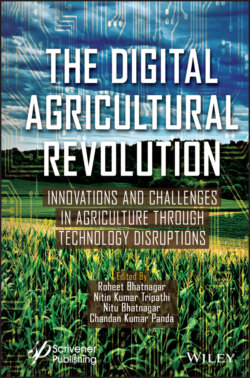Читать книгу The Digital Agricultural Revolution - Группа авторов - Страница 56
2.4 Importance of Remote Sensing in Crop Yield Estimation
ОглавлениеAs remote sensing provides up-to-date, precise, and cost-effective information, remote sensing and GIS support agricultural production monitoring toward sustainable agricultural systems. The application of remote sensing technology agricultural operations requires high accuracy and reliable data with data quantitative processing facility [52]. For crop yield prediction, very highly accurate and reliable data are necessary. It was clear from the studies that even after a long time of research (more than 20 years), no regular crop yield estimation method suitable for a wide range crops was developed; however, a huge amount of work done was shown and is an important step in this field.
Remote sensing imageries have the potential to provide spatial information of features at any scale on earth at real-time basis. Remote sensing imageries have the potential not only in identification of crop classes but also in estimation of crop yield. A wide number of sensors data is useful for yield estimation of crops. Soil moisture, NDVI, surface temperature and rainfall data were considered for assessment of crop yield, using piecewise linear regression method with breakpoint, found predicted values very close to observed values (R2 = 0.78) for corn and for soybean crop (R2 = 0.86) [53]. Poststratified estimator of crop yield using satellite data (IRS-1B-LISS-II) along with crop yield data from crop cutting experiments for small area estimated crop yield at tehsil/block level with the existing sampling design [54]. A simple linear statistical relationship between normalized difference vegetation index and yield used for estimation of paddy, corn, wheat, and cotton crops was developed [55]. Corn yield scenarios was constructed from the AVHRR-based temperature condition index (TCI) and vegetation condition index (VCI) at approximately 42 days prior to harvest time [56]. Recent studies used low altitude helicopter and unmanned aerial vehicle (UAV) for field scale yield prediction. A study using UAV at 20 m height revealed that NDVI values were highly correlated with yield and total biomassat panicle initiation stage [57].
Although a large amount of research has been done on this, there is no particular best yield estimation method available [58, 59]. Training of neural network with RS data can be done to predict crop yield. It is also possible with big satellite data analytics also with neural network.
